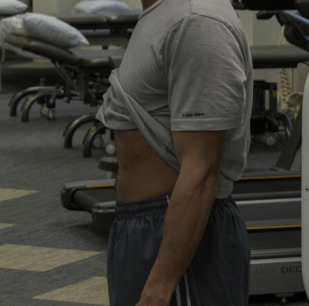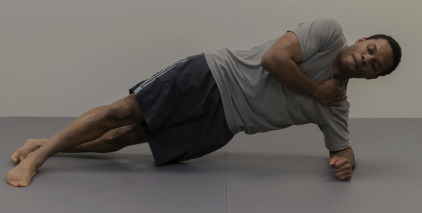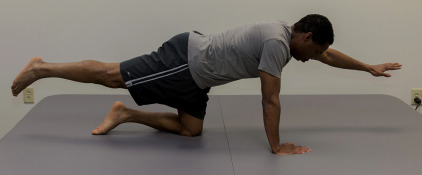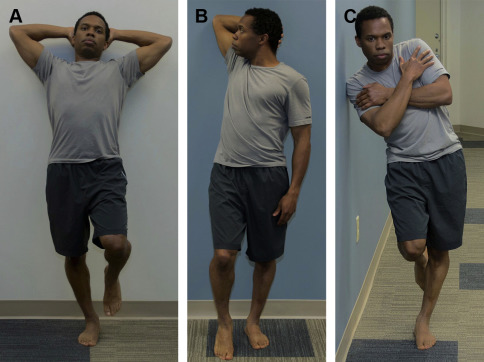Core muscles provide stability that allows generation of force and motion in the lower extremities, as well as distributing impact forces and allowing controlled and efficient body movements. Imbalances or deficiencies in the core muscles can result in increased fatigue, decreased endurance, and injury in runners. Core strengthening should incorporate the intrinsic needs of the core for flexibility, strength, balance, and endurance, and the function of the core in relation to its role in extremity function and dysfunction. Specific exercises are effective in strengthening the core muscles.
Key points
- •
Core muscles provide stability that allows generation of force and motion in the lower extremities, distributes impact forces, and allows controlled and efficient body movements.
- •
Imbalances or deficiencies in the core muscles can result in increased fatigue, decreased endurance, and injury in runners.
- •
Core strengthening should incorporate the intrinsic needs of the core for flexibility, strength, balance, and endurance, and the function of the core in relation to its role in extremity function and dysfunction.
- •
Specific exercises are effective in strengthening the core muscles.
What is the core?
- •
A common view of the core or lumbopelvic hip complex of the body includes the spine, hips and pelvis, proximal lower limbs, and abdominal structures. The principal function of this complex is to create stability for the generation of force and motion in the distal joints.
- •
When the system works efficiently, the result is appropriate distribution of forces, optimal control and efficiency of movement, and functional movement through the kinetic chain.
- •
Core stability has been defined as “the ability to control the position and motion of the trunk over the pelvis and leg to allow optimum production, transfer and control of force and motion to the terminal segment in integrated kinetic chain activities.”
- •
McKeon and colleagues proposed a foot-core paradigm that describes the importance of base of support in running. This article focuses on the lumbopelvic control as it relates to running injuries, acknowledging that the full kinetic chain is critical to evaluate because it relates to running mechanics and injury prevention.
What is the core?
- •
A common view of the core or lumbopelvic hip complex of the body includes the spine, hips and pelvis, proximal lower limbs, and abdominal structures. The principal function of this complex is to create stability for the generation of force and motion in the distal joints.
- •
When the system works efficiently, the result is appropriate distribution of forces, optimal control and efficiency of movement, and functional movement through the kinetic chain.
- •
Core stability has been defined as “the ability to control the position and motion of the trunk over the pelvis and leg to allow optimum production, transfer and control of force and motion to the terminal segment in integrated kinetic chain activities.”
- •
McKeon and colleagues proposed a foot-core paradigm that describes the importance of base of support in running. This article focuses on the lumbopelvic control as it relates to running injuries, acknowledging that the full kinetic chain is critical to evaluate because it relates to running mechanics and injury prevention.
Local system
- •
Defined as muscles that originate and/or insert on the lumbar vertebrae, with the exception of the psoas. Includes multifidus, transverse abdominals (TA), internal obliques, and the pelvic floor muscles.
- •
Position dependent and acts locally.
- •
Controls curvature, stiffness, and stability of the lumbar spine.
Physiology/biomechanics
Several mechanisms influence spine stability and maintenance of a neutral spine.
- •
Increasing intra-abdominal pressure contributes to spine stability. One way to stimulate this is by contracting the TA, but it has been shown that to maintain a neutral spine, cocontraction of muscles is of foremost importance and that no 1 muscle is more important than others for this.
- •
Spinal stability is required before limb movement.
- •
Because running is an endurance event, core stability must include endurance training of the core musculature to maintain stability.
- •
To create a stable base we recommend starting with exercises that can promote cocontraction while maintaining low compression loads in the spine ( Figs. 1–7 ). A solid base will later allow for control movements.

Fig. 1
Abdominal hollowing. Involves drawing in the abdominal wall while the shoulders, ribs, and pelvis remain still and normal breathing is maintained. Coactivates the transverse abdominis and multifidus. This technique was designed to regroove motor control patterns, not to provide stability.

Fig. 2
Abdominal bracing. Submaximal isometric contraction of the 3 layers of the abdominal wall (rectus, obliques, and transverse) produces a muscular girdle; 10% of the maximal voluntary contraction provides enough stability.

Fig. 3
Side bridge. Lie on your side with your elbow underneath you; rise up so that you are resting 1 forearm/elbow and foot on same side. Place the top foot in front of the lower foot on the mat for support. The test ends when the hips return to floor.

Fig. 4
Bird dog. Get down on your hands and knees with your palms flat on the floor and shoulder width apart. Your knees should be hip width apart and bent 90°. Brace your core and, maintaining a neutral spine (no deviation of spine or hips), raise the opposite arm and leg simultaneously, holding for 6 to 8 seconds, and alternate. Avoid raising the extremities past horizontal. To increase challenge do not return knee or hand to floor when coming back to starting position and repeat same side (like sweeping the floor).

Fig. 5
Eccentric retraining of the abdominals. ( A ) Sagittal. Standing approximately 3 inches away from a wall, try to slowly move the body backwards, keeping feet flat on the floor, to just barely touch the head against the wall. Initially, this can be done with both legs on the ground, then progressed to toe-touch weight bearing on each side and ultimately to single-leg standing. Sagittal plane core strength testing creates eccentric activation in the abdominals, the quadriceps, and hip flexor muscles, and concentric activation in the hip and spine extensors. ( B ) Transverse. Stand about 3 inches away from the wall, and progress as for the sagittal plane test from bilateral weight bearing to single-leg stance and alternately touch 1 shoulder then the other just barely against the wall. Quality of motion and speed can be assessed. This test evaluates transverse plane motions that incorporate abdominal muscles, hip rotators, and spine extensors. ( C ) Frontal. Standing with one side against the wall, brace your core and keep a neutral spine. Toe touching on the inside leg, barely touch the inside shoulder to the wall. This test evaluates eccentric strength of the quadratus lumborum, hip abductors, and some long spinal muscles that are working in a frontal plane. Can progress to single leg for more challenge.
Fig. 6
Curl up. Lying on your back with 1 leg bent with the knee flexed and the other on the floor, brace the abdominals. Elevate the head and shoulders a short distance off the floor. Focus on midthoracic flexion while the head and neck remain locked. To increase the challenge, hold the contraction and take a deep breath before relaxing.
Fig. 7
Planks. In push-up position on the floor, bend your elbows 90° and rest your weight on your forearms. Your elbows should be directly beneath your shoulders, and your body should form a straight line from your head to your feet. Hold the position for as long as you can (at least 8–10 seconds), go to the original position, and repeat.
- •
Isometric exercises should be held for no more than 8 seconds, then relax and repeat. This technique allows adequate oxygenation of the muscles, avoiding the buildup of harmful lactic acid.
Panjabi suggested that 3 subsystems work together to provide stability:
- •
Passive subsystem
- ○
Ligaments, vertebral bodies, and intervertebral discs: do not produce force or motion, mainly provide for position/motion sense and communicate with neural system.
- ○
- •
Active subsystem
- ○
Muscles and tendons: generate forces.
- ○
- •
Neural subsystem
- ○
Nerves and the central nervous system: determines stability requirements and makes the active system achieve the stability goals.
- ○
Basic running biomechanics
- •
Running at any speed can be defined as loss of double-leg support during the gait cycle. Running generally is divided into a stance phase, swing phase, and float phase.
- •
The pelvis, sacrum, and lumbar vertebrae provide stability to allow the lower extremities to move effectively while running. The pelvis relies on symmetry to function during the running cycle. The planes of motion of the pelvis are rotational, anterior-posterior, and mediolateral. Pelvic biomechanical abnormalities that lead to the most injuries in runners include excessive anterior pelvic tilt, excessive lateral tilt, and asymmetric hip movement. This abnormal pelvic orientation also can lead to excessive strain on the hamstrings, which can increase the risk of injury.
- •
The core muscles help absorb and distribute impact forces and allow body movements in a controlled and efficient manner. When optimized in function, muscles work in unison to allow breathing during running and the twisting motion required during the running cycle. As the pelvis rotates during each stride, the muscles of the thorax keep the spine and the abdomen stable about the axis of the vertebrae.
- •
The float phase includes forward rotation of the ipsilateral pelvis and hip flexion caused by the psoas and other pelvic muscles, along with the core, to allow twisting of the pelvis.
- •
Abnormal pelvic mechanics that can lead to overuse injuries include tight muscles that attach to the pelvis, including tensor fascia latae, hamstring, adductors, quadratus lumborum, piriformis, weak muscles like gluteus medius (GMed), gluteus maximus (GMax), and structural deformities like scoliosis or leg length discrepancy.
- •
The hip flexes (starting with the psoas) and abducts during the swing phase and extends and adducts during stance.
- ○
Hamstring and the hip extensors start activating in the second half of swing and reach maximal power at beginning of stance.
- ○
Abductors and adductors provide cocontraction stability for the stance leg.
- ○
To train this, it is necessary first to “wake up/regroove” the hip musculature. The exercises shown in Figs. 8–12 can be helpful.
- ○








